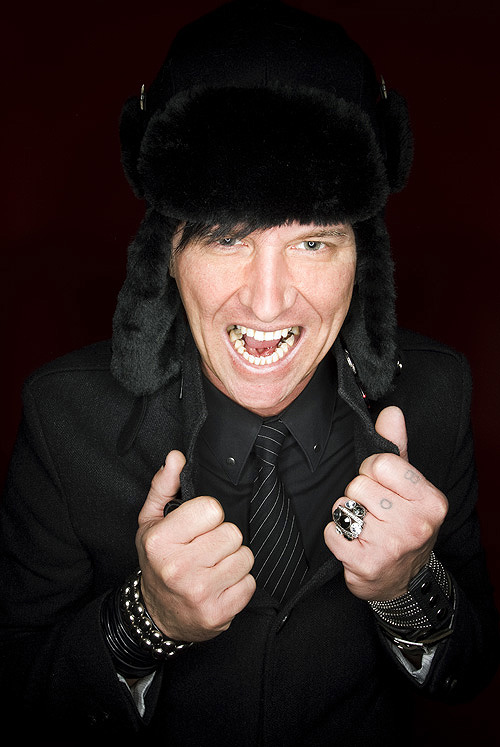 The influential reality TV show Project Runway has put Portland and its designers in the fashion spotlight. But the bright lights haven’t brought stability to the local fashion industry.
The influential reality TV show Project Runway has put Portland and its designers in the fashion spotlight. But the bright lights haven’t brought stability to the local fashion industry.
 |
| Seth Aaron Henderson, Season 7 winner on Project Runway, is one of the few Runway designers staying in the area. // Photo by PAULA WATTS |
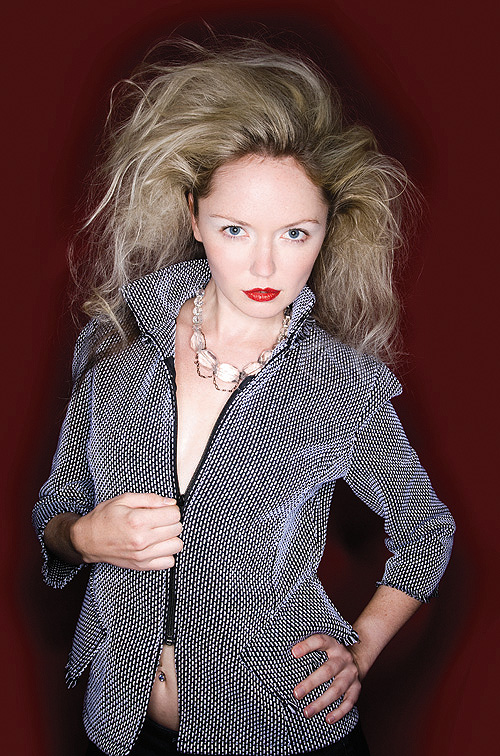 |
| Model Katya Timokhina wears a zipper jacket by Seth Aaron Henderson and rock crystal necklace by Anne Bocci Design. // Hair and makeup by Sunny Davis // Styling by Jon Taylor Carter |
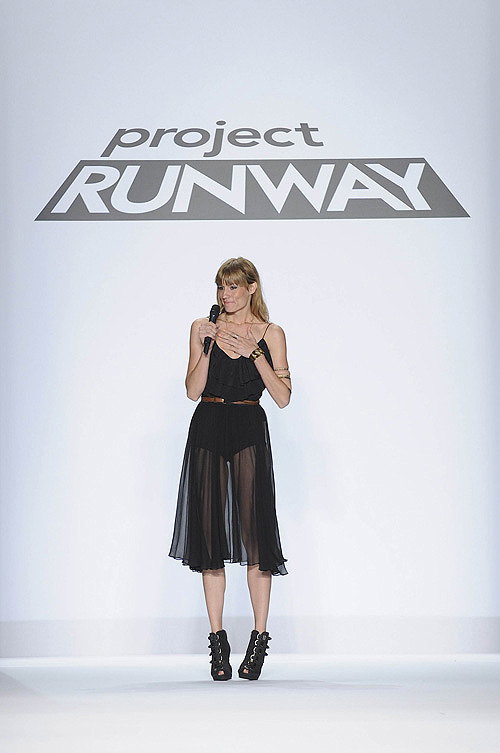 |
| Portlander Gretchen Jones was Project Runway’s Season 8 winner. She moved to New York City after winning. // Photo by Barbara Nitke/Lifetime Television |
| {artsexylightbox singleImage=”images/stories/articles/archive/dec2010/slideshow-intro-runwayreality.jpg” path=”images/stories/articles/archive/dec2010/RunwayReality”}{/artsexylightbox} |
BY JENNIFER NETHERBY
Seth Aaron Henderson took a bow as he walked out on the catwalk to the cheers of a packed hometown crowd armed with camera phones at Portland Fashion Week in October. The Vancouver, Wash.-based designer, at the time the reigning winner of fashion design reality show Project Runway, had just presented his futuristic concept collection, “Solar is the New Black,” sponsored by Hillsboro solar panel maker SolarWorld. Even before he presented the collection, the partnership drew national media attention for not only him, but for SolarWorld and Portland Fashion Week.
Since his run on the show earlier this year, Henderson’s every fashion move has been covered by media, from interviews immediately after with everyone from Good Morning America to People magazine to local coverage of his appearances at Portland fashion events. When he signed autographs and showed off a new collection in August at Anne Bocci, the Multnomah Village boutique where his clothes are sold, Vitamin Water signed on as a sponsor.
Known for well-made clothes with a rocker sensibility, the 39-year-old Henderson is one of four recent Project Runway contestants from Portland, and one of three who have been crowned winners. In October, the show’s judges named Portland designer Gretchen Jones the winner of Season 8. The multiple wins have boosted the city’s image in fashion along with that of each designer.
Project Runway has had great success recruiting here. Not only has the show begun to hold auditions in Seattle for its most recent seasons, but producers have kept watch on local designers, courting them and encouraging them to audition for the show.
“We’ve continued to go back for a reason because we have found great designers,” says Project Runway executive producer Sara Rea.
But while Portland has proven to be a good place to find up-and-coming designers, Project Runway success hasn’t brought stability to the city’s emerging fashion scene.
Portland is a magnet for young designers, but it struggles to keep its star talent. Hard numbers on how many fashion designers live here are hard to come by, since most local fashion designers sew on off hours from jobs as waiters or baristas that pay the rent. A popular career path is to start a line in Portland, get into local boutiques, find a moderate amount of success (or land a spot on Project Runway) and then leave town.
Of the four Portlanders on Project Runway, three have left. Season 5 winner Leanne Marshall and Season 8’s Jones moved to New York City immediately after their wins. Season 7 contestant Janeane Marie Ceccanti took a full-time job with a design house in Florida.
“I was burnt out on being broke and looking at the whole scope of things, I realized I had to start marketing outside of Portland if I was going to have any financial success,” says the 29-year-old Ceccanti. “It’s really hard for me to leave Portland, but if I want to be in women’s fashion, I have to leave.” Henderson, who has two kids in school here, is staying, even buying a new house in Vancouver. Before the show he made a living as a stylist, and his win has largely made it possible to stay and make a living as a designer.
His Project Runway winnings include $100,000 and a contract with New York-based Designer Management Agency to develop his label into a recognizable brand. He’s so far been able to parlay his success into a deal to design a line of handbags with a yet-to-be-announced NYC fashion house and is headed to Beijing Fashion Week, where he hopes to break into the Chinese market with his own clothing line.
“If you’re just a designer here, it’s very difficult,” Henderson says. “You could probably have a little store and make $50,000 a year but you’re not going to have a label unless you’re in this situation.”
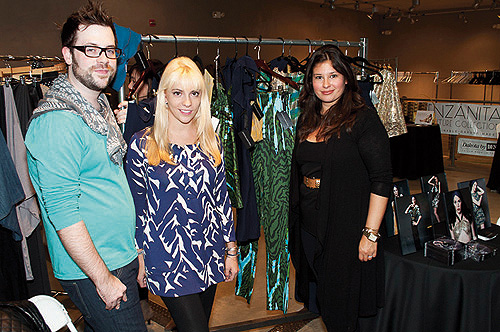 |
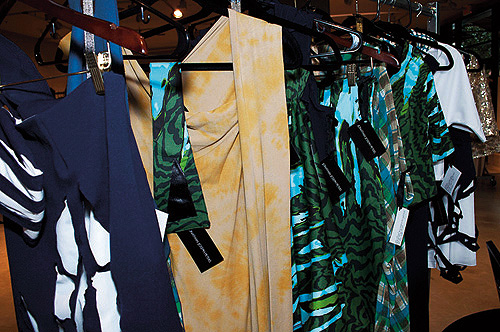 |
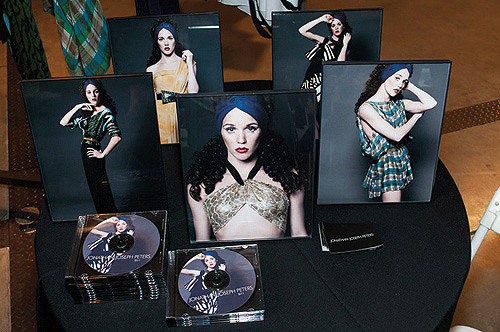 |
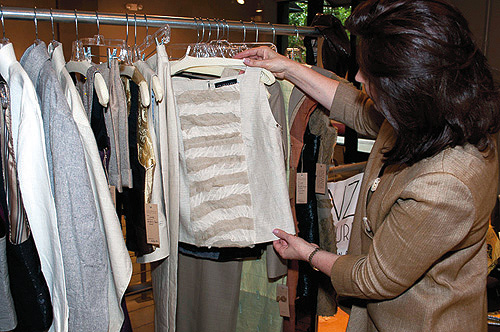 |
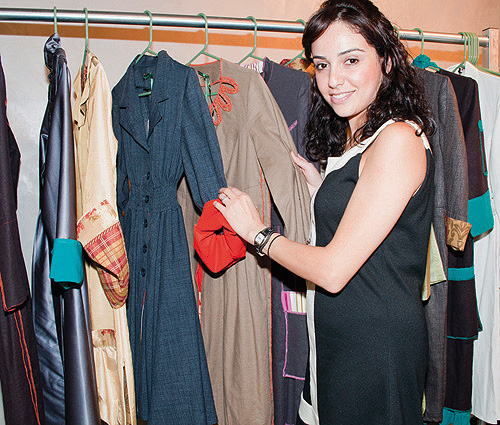 |
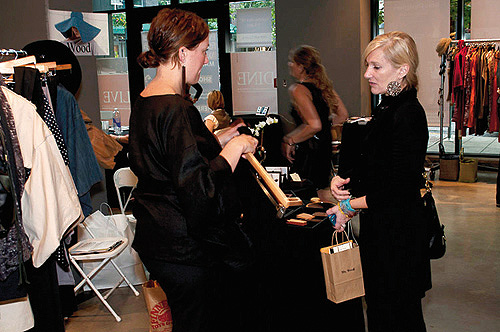 |
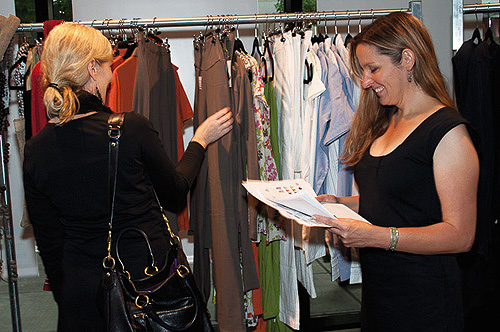 |
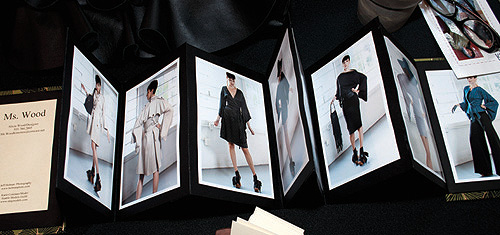 |
Designers talk with buyers at Portland Fashion Week’s first-ever Industry Showroom, where boutique owners were able to meet with designers, browse samples and place orders. The event was aimed at driving business for designers showing at PFW. (Top to bottom): Jonathan Joseph Peters with stylist and fashion writer Christina K. Pierce and Rosanna Ortiz-Sinel, founder of fashion week StyleWeek Providence; Peters’ designs and display table; a shopper looks through racks; Rana Ghezelayagh of anaR Couture with her collection; designer Alicia Wood talks with buyer Anne Bocci, owner of a boutique in Multnomah Village; Bocci shops for clothing while talking with Leslie Leroux of Ethos Paris; a detail of Alicia Wood’s event booth. |
What Portland lacks are basic fashion resources and local support. Finding fabric and other materials at a competitive cost and in large enough quantities for a line is difficult, if not impossible, designers say. Getting a line manufactured locally can be costly since the few manufacturers based here are smaller and don’t mass-produce items like factories in other U.S. cities or in Asia.
Celeste Sipes, a designer and owner of Radish Underground, a boutique that sells clothes from independent designers, said it can cost as much as $45 to get a skirt made locally. Adding to that the cost of material, and a $10 to $15 profit for the designer, can alone push the wholesale price up to $65 or $70.
Retailers then mark up the price as much as double what they pay wholesale.
Runway’s Ceccanti said after retail markups her T-shirts generally sell in stores for $95, while her jackets can run as high as $700. After subtracting material costs, the money she makes for the time spent designing and sewing can make it a below-minimum-wage job. Finding consumers willing to spend that much for a no-name local designer is difficult.
“The market really isn’t here,” she says. “My ideal customer here is poor, like me. Everyone kind of works trade and that’s really great because it means everyone is really supportive of each other, but you can’t trade for your groceries.”
Designers who are able to sell a full collection to boutiques buy materials in Los Angeles or other places and often manufacture their lines there as well. But even those designers have hit a ceiling on success in Portland.
Anna Cohen ran her own eponymous fashion line from here for three years. Her clothes were featured in spreads in Vogue and Elle magazines and were sold in boutiques across the country. But she was unable to find local investors to grow her business, forcing her to run it with interns and borrowed money.
“When Vogue is calling, what do you do? You just have to say yes, at least that’s what I thought,” she says. “I kept having to take out money and borrow money and live very frugally for a long time.”
Each new fashion magazine spread brought more orders, which required more money. The way fashion works, it can take 18 months to earn back money from sales. Cohen’s breaking point came in March 2008, after fabric came back from her L.A. manufacturer with seams unraveling, forcing her to cancel orders. She folded the same month her clothes were featured in O, The Oprah Magazine, a glaring example of the disconnect between image and business reality.
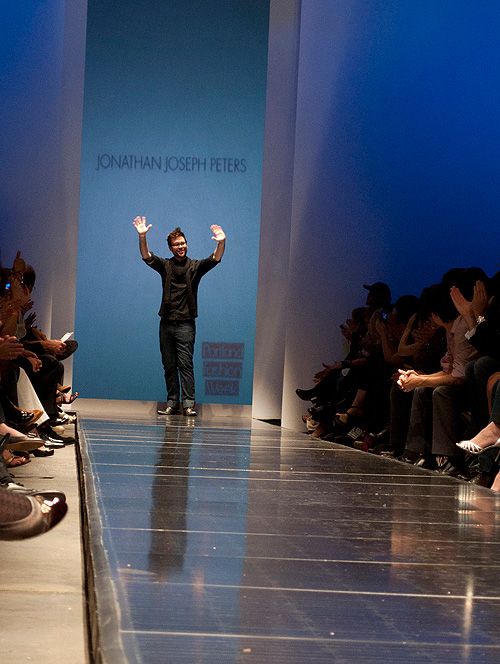 |
Jonathan Joseph Peters waves to the crowd after presenting his first collection since his Project Runway run at Portland Fashion Week. |
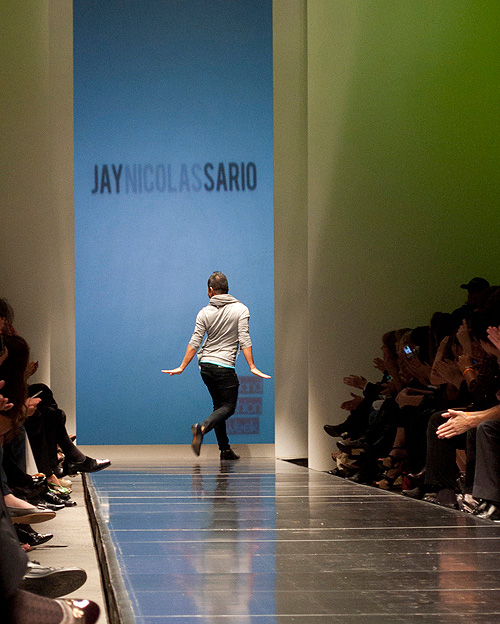 |
Project Runway finalist Jay Sario takes a bow as he heads off the runway after presenting his denim-heavy spring collection at PFW. // Photos by Shaun Strickland |
Supermodel Heidi Klum reminds competitors on each episode of Project Runway that, “In fashion, one day you’re in, next you’re out.” Henderson’s strategy is to capitalize on his buzz while he’s still in, building a business foundation. Not only is he now a name, Project Runway has given him access to top designers and industry insiders that he wouldn’t have otherwise, but he also says ultimately it comes down to “how hard do you want to work for it.”
Henderson wants to be a fashion icon as recognizable as Christian Dior or Alexander McQueen with his Seth Aaron label carried in high-end stores such as Neiman Marcus on down to mass market retailer H&M.
“It all comes down to doing the work and putting yourself out there,” he says. “You’ve got to put yourself out there.”
He’s also been happy to use his profile to benefit the rest of Portland fashion.
Since his run, there have been more shoppers coming through Anne Bocci, which has carried his dresses for the last three years and where he’s made frequent appearances. Most come to browse dresses hand-sewn by the Project Runway winner that sell for as much as $395; more popular sellers have been autographed $49 skull pins from his accessories line. “We can’t keep them in stock,” Bocci says.
Other local stores that carry clothes from Project Runway designers say they’ve had some customers seek them out for the clothes, but most leave without a purchase.
Portland Fashion Week, which featured the 30-year-old Leanne Marshall before her Project Runway win and has helped identify other up-and-coming designers here, capitalized on Henderson’s success for this year’s show. Organizers reached out to Henderson and his fellow Runway finalists Jay Sario and Jonathan Joseph Peters for a show featuring the Runway designers.
Executive director Chris Cone said they saw it as a way to draw in wholesale buyers and national press for the first time, part of a bid to move Portland Fashion Week from being a “local entertainment” to a show that buyers will look to when placing orders.
“It all comes together for me into a picture where we can build kernels of an industry here so that designers, when they start getting those bites of success, don’t feel like they need to leave to let their business grow,” Cone says.
For this year’s show, organizers added an industry showroom for designers to meet with buyers and a public showroom where designers could sell clothes. Most buyers who attended were from local boutiques, rather than national chains or boutiques from other cities.
Like many Portland designers, Portland Fashion Week has made eco-friendly fashion its niche, setting the industry here apart from other cities. It has helped organizers attract sponsors such as German airline Lufthansa, which doesn’t even fly through PDX, hair-care line Pureology and SolarWorld. (And it hasn’t gone unnoticed by Project Runway producers.)
Meanwhile, the city and local designers have started their own efforts to make business sustainable for designers.
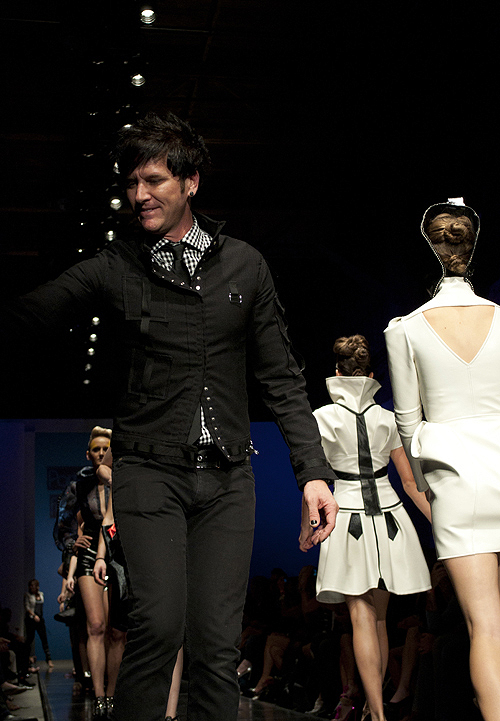 |
Seth Aaron Henderson walks the runway after his show headlining Portland Fashion Week in October. “The Northwest has been very supportive of me,” Henderson says. // Photo by Shaun Strickland |
Earlier this year, the Portland Development Commission considered creating a fashion incubator to support designers with low-cost retail space downtown but ultimately abandoned efforts because of the “limiting conditions with the real estate we were considering and the substantial financial investment it would have required,” says spokeswoman Katherine Krajnak. Last year, local designers started Portland Fashion Synergy, a nonprofit geared at building the local industry, which plans to roll out education initiatives for designers next year.
New businesses catering to designers have also sprung up. The Portland Garment Factory started as a side project for Portland designer Britt Howard after she couldn’t find a manufacturer for her children’s line. Howard and partner Rosemary Robinson now employ five sewers and are moving into a 5,000-square-foot space in Southeast Portland to accommodate the growing number of mostly local designer clients.
Designer Alice Dobson is expanding her manufacturing business Alice Inc., which manufactures her Sofada line and clothes for Jet, Lisa Reitz, Ipseity and other local designers.
Dobson also consults with local designers. She herself has been one of the city’s most successful, becoming the first to go to New York Fashion Week in 2006 and supporting herself through sales of her clothes through her own boutique on East Burnside and to other stores along the West Coast. She credits her success partly to Portland.
“Being in Portland was the best thing for my business,” she says, noting that she spent two years as a designer in Los Angeles. “I think it’s way harder than somewhere else. Maybe people don’t realize it.”
She and others point out that fashion itself is a tough business. Dobson, in fact, is closing her boutique after eight years because it’s no longer viable. But she plans to build on Alice Inc. and wholesale sales of her Sofada line. She’s also considering auditioning for Project Runway after producers contacted her, encouraging her to try out.
Project Runway may not automatically translate into success, but it does offer the possibility.
“I think what Seth Aaron really did is make high fashion seem possible for Portlanders,” says Karen Vitt, editor of the Neat Sheet, a growing Portland fashion site. “He has made the whole local fashion scene seem more glamorous and exciting and rich with possibility. The reality may not be quite so glamorous, but then again, when was fashion about reality?”

